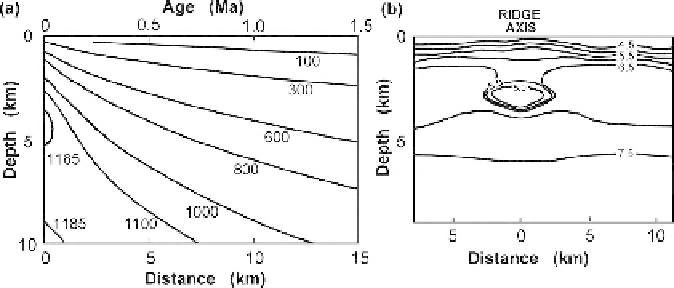Geoscience Reference
In-Depth Information
Figure 9.21.
(a) Temperature in oceanic crust calculated for a mid-ocean ridge with a
half-spreading rate of 1 cm yr
−1
. The edge of the magma chamber is indicated by the
1185-
◦
C isotherm (the solidus). The chamber is confined to depths appropriate for
layer 3 and is only about 1 km wide. (From Sleep (1975).) (b) A seismic P-wave
velocity model for the East Pacific Rise at 9
◦
N (half-spreading rate 6.1 cm yr
−1
) based
on the first thermal model discussed in Section 9.4.3. (From Hale
et al
.(1982).)
To calculate thermal models of mid-ocean ridges, we need to know some-
thing about the eruption and solidification temperatures of likely crustal and
upper-mantle materials. Estimates of 1203-1246
◦
Chave been made for the erup-
tion temperature of basalts collected from the FAMOUS area of the Mid-Atlantic
Ridge. In melting experiments on a Mid-Atlantic Ridge basaltic glass, clinopy-
roxene disappeared at 1166
◦
C, plagioclase at 1215
◦
C and olivine at 1245
◦
C.
When melting a Mid-Atlantic Ridge olivine tholeiite (at 0.15 GPa), it was found
experimentally that clinopyroxene disappeared at 1160
◦
C, plagioclase at 1180
◦
C
and olivine at 1210
◦
C.
Thermal models of mid-ocean ridges are computed numerically by using the
heat-conduction equation, Eq. (7.59). The exact size and shape of any magma
chamber depends on the assumptions made about the latent heat of solidification
and the temperatures for the boundary conditions, as well as the spreading rate.
Figure 9.21(a) shows one steady-state model made for a ridge spreading with a
half-rate of 1 cm yr
−
1
.Inthis model, the temperature at the base of the lithosphere
was assumed to be 1290
◦
C, the edge of the magma chamber was defined by the
1185-
◦
C isotherm, and all the latent heat was released at the axis. The maximum
half-width of this magma chamber is about 0.5 km. In another model, the temper-
ature at the base of the lithosphere and along the intrusion axis was assumed to be
1125
◦
C, the edge of the magma chamber was defined by the 1000
◦
C isotherm
and the latent heat was distributed over the liquidus-solidus interval. The max-
imum half-width of this chamber is about 4 km (or 3 km if the latent heat is
released entirely at the solidus). Some of the apparent difference between these
two models is due to the different assumptions regarding temperature, and some
is due to the different treatments of latent heat and upper boundary conditions.

